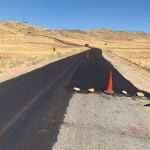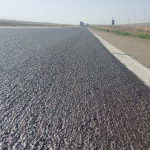Slurry seal is a mixture of well-graded fine aggregate with mineral filler and dilute asphalt emulsion. A single course is usually applied in thicknesses of 3–6 mm. Slurry seals are effective in areas of excessive oxidation and hardening of the existing asphalt and are used for sealing minor surface cracks and voids, retarding surface raveling, delineating different pavement surface areas, and, with proper aggregate, improving surface friction characteristics.
Aggregate, water, emulsion (slow or quick setting), and additive are proportionately mixed together in a slurry machine on the job site and immediately applied to the paved surface with a device. Additives such as Portland cement, hydrated lime, or aluminum sulfate liquids are often used in small quantities as stabilizers or chemical modifiers to aid in setting the slurry.
Slurry seal mixtures are divided into two categories, normal and quick-setting, according to the raw materials used in them. In the normal slurry seal mixtures, slow setting emulsion bitumen is used, and they do not necessarily have mineral filler as an accelerator of emulsion bitumen setting. In quick-setting emulsion bitumenو by adding mineral filler as an accelerator of emulsion bitumen setting, it is possible to achieve a quick-setting slurry seal mixture.
In this regard, Raika Rah Gostar Refining and Distribution Company is able to produce bitumen emulsion for slurry seal using emulsifiers for slurry seal (AkzoNobel and Cecca).
In this company, we were able to supply bitumen emulsion for slurry seal in the road construction projects in different regions of the country and neighboring countries, relying on the expertise and experience of several years in this field.
It should be noted that the experienced laboratory staff of Raika Refining and Distribution Company has the ability to perform all the tests required to check the quality and performance of bitumen emulsion for slurry seal.
Table 1: Standard requirements for aggregate tests of bitumen emulsion for slurry seal
| Range | Standard | Test | |
| Max. | Min. | ||
| 35 | – | ASTM D131 | Los Angeles Abrasion Value (%) |
| 15 | – | ASTM D88 | Soundness Loss by Sodium Sulfate, (%) |
| – | 45 | ASTM D2419 | Sand Equivalent, (%) |
Table 2: Standard requirements for tests of bitumen emulsion for slurry seal
| Range | Standard | Test | |
| Max. | Min. | ||
| Tests on Bitumen Emulsion | |||
| 100 | 20 | ASTM D7496 | Viscosity, Saybolt-Furol @ 25°C |
| 1 | – | ASTM D6930 | Storage Stability, 24 h (%) |
| 0.1 | – | ASTM D6933 | Sieve (%) |
| Positive | ASTM D7402 | Particle Charge | |
| – | 60 | INSO 13581 | Residue by Distillation (%) |
| Tests on Residue | |||
| 90 | 40 | INSO 2950 | Penetration @ 25°C, 5 sec (1/10 mm) |
| – | 57 | ASTM D36 | Softening Point (°C) |
| – | 40 | INSO 3866 | Ductility @ 25 °C (cm) |
| – | 97 | ASTM D7553 | Solubility in Trichloroethylene (%) |
| – | 50 | AASHTO T301 | Elastic Recovery (%) |
Table 3: Standard requirements for mix design of slurry seal mixture
| Quick-setting Slurry Seal | Normal Slurry Seal | Standard | Test | |||
| Max. | Min. | Max. | Min. | |||
| – | – | 3 | 2 | ISSA TB106 | Consistency )cm) | |
| – | 180 | – | 180 | ISSA TB113 | Mixing time, (s) | |
| – | 30 | – | 30 | ASTM D3910 | Set time, (min) | |
| – | 90 | – | 90 | ISSA TB114 | Wet stripping (%) | |
| – | 12 | – | – | ISSA TB139
ASTM D3910 |
30 min (set) |
Cohesion (Kg-m) |
| – | 20 | – | – | 60 min | ||
| 807 | – | 807 | – |
ISSA A105 |
1-hour | Wet track abrasion loss, (g/m2) |
| – | – | – | – | 6 days | ||
| 538 | – | 538 | – | ISSA TB109 | Sand adhesion by loaded wheel tester (LWT) (g/m2) | |





